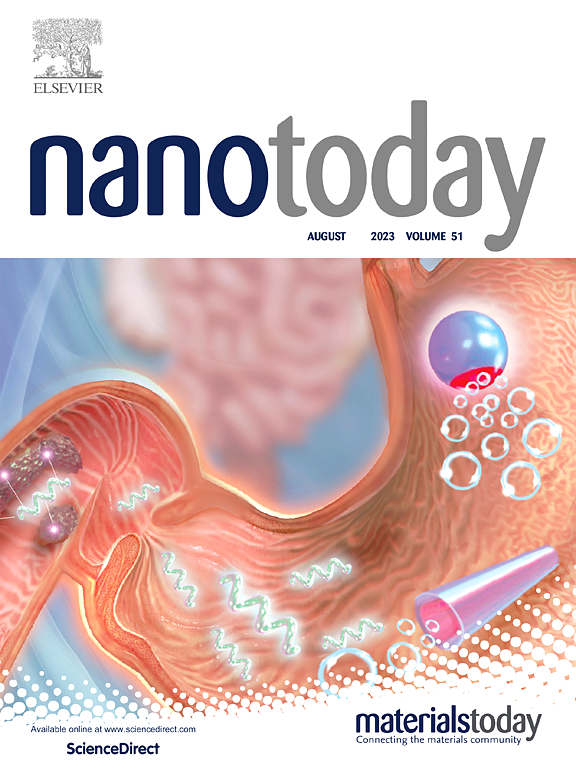具有自适应信号放大的可拆卸驱动的荧光纳米探针用于全血中碳酸酐酶的定量检测和增强癌症成像
IF 10.9
1区 材料科学
Q1 CHEMISTRY, MULTIDISCIPLINARY
引用次数: 0
摘要
碳酸酐酶(CA),特别是CAⅨ,是癌症诊断和治疗中的关键生物标志物,但由于其固有的背景荧光、有限的信号放大和血液自身荧光的干扰,在全血中进行定量检测仍然具有挑战性。在这里,我们介绍了一种分解驱动的荧光纳米探针(SQ-H-SA),利用自组装、识别驱动激活和自适应信号放大。SQ- h - sa利用squaraine (SQ)染料在水溶液中自组装成稳定的荧光猝灭聚集体;在CAs结合后,纳米探针分解,使SQ单体在蛋白质的疏水口袋内成为构象屏蔽,在与3 μ CAⅨ相互作用的几分钟内实现了45倍的荧光增强。SQ-H-SA纳米探针具有良好的选择性(受血清白蛋白的干扰有限),亚纳摩尔灵敏度和大的信本比,通过超低的固有荧光和蛋白质辅助扩增实现。SQ-H-SA基于内部过滤效应有效抑制血液自身荧光,实现内源性CAs的可靠定量。值得注意的是,SQ-H-SA不仅检测到未经治疗的肺癌患者中CAs水平升高,而且与ELISA结果一致,治疗后显著降低,而且有助于临床标本的高通量分析,以提高液体活检的诊断精度。此外,SQ-H-SA在癌细胞和临床肺癌组织中首次实现了CAⅨ的选择性、细胞膜特异性荧光成像。本文章由计算机程序翻译,如有差异,请以英文原文为准。
Disassembly-driven turn-on fluorescent nanoprobe with adaptive signal amplification for quantitative carbonic anhydrase detection in whole blood and enhanced cancer imaging
Carbonic anhydrases (CAs), particularly CA Ⅸ, are critical biomarkers in cancer diagnosis and therapy, but quantitative detection in whole blood remains challenging due to intrinsic background fluorescence, limited signal amplification, and interference from blood autofluorescence. Here, we introduce a disassembly-driven fluorescent nanoprobe (SQ-H-SA) leveraging self-assembly, recognition-driven activation, and adaptive signal amplification. SQ-H-SA harnesses squaraine (SQ) dyes that self-assemble into stable, fluorescence-quenched aggregates in aqueous solution; upon CAs binding, the nanoprobe disassembles, enabling SQ monomers to become conformationally shielded within the protein’s hydrophobic pocket, achieving a rapid 45-fold fluorescence enhancement within minutes of interaction with 3 μM CA Ⅸ. SQ-H-SA nanoprobe exhibits good selectivity (with limited interference from serum albumin), sub-nanomolar sensitivity, and large signal-to-background ratio, enabled by ultralow intrinsic fluorescence and protein-assisted amplification. By effectively suppressing blood autofluorescence based on the inner filter effect, SQ-H-SA achieves reliable quantification of endogenous CAs. Notably, SQ-H-SA not only detected elevated CAs levels in untreated lung cancer patients and notable posttreatment reductions consistent with ELISA findings, but also facilitated high-throughput analysis of clinical specimens to improve diagnostic precision in liquid biopsies. Moreover, SQ-H-SA achieves the first selective, cell membrane-specific fluorescence imaging of CA Ⅸ in cancer cells and clinical lung cancer tissues.
求助全文
通过发布文献求助,成功后即可免费获取论文全文。
去求助
来源期刊

Nano Today
工程技术-材料科学:综合
CiteScore
21.50
自引率
3.40%
发文量
305
审稿时长
40 days
期刊介绍:
Nano Today is a journal dedicated to publishing influential and innovative work in the field of nanoscience and technology. It covers a wide range of subject areas including biomaterials, materials chemistry, materials science, chemistry, bioengineering, biochemistry, genetics and molecular biology, engineering, and nanotechnology. The journal considers articles that inform readers about the latest research, breakthroughs, and topical issues in these fields. It provides comprehensive coverage through a mixture of peer-reviewed articles, research news, and information on key developments. Nano Today is abstracted and indexed in Science Citation Index, Ei Compendex, Embase, Scopus, and INSPEC.
 求助内容:
求助内容: 应助结果提醒方式:
应助结果提醒方式:


